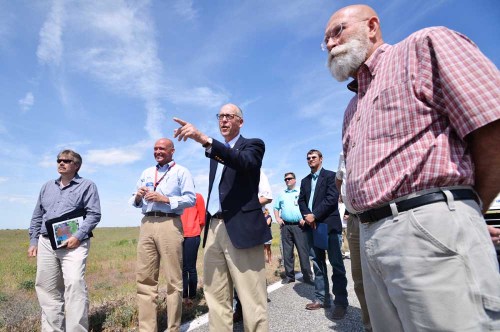With one major hurdle left, depot transfer set for Dec. 1
Published 5:42 pm Wednesday, September 6, 2017

- Congressman Greg Walden, center, gestures while asking a question while on a tour of the Umatilla Army Depot with the Columbia Development Authority on Tuesday west of Hermiston.
After years of delays on transferring the former Umatilla Chemical Depot to local control, Columbia Development Authority director Greg Smith believes the project could be just a few months away from the finish line.
“We’ve set a hard deadline of December 1,” he said before adding, “The joke is, ‘What year?’”
Locals have reason to be skeptical that the depot is less than three months away from being opened up to private economic development that could mean millions of dollars of investment and hundreds of jobs for the area. They’ve been promised “soon” for several years. Smith said when he was hired on in July 2015, he was told the transfer was about 90 days away. That was after a previous timeline had set a transfer date at the beginning of 2015.
In the time since, Smith said the area has lost out on many large projects. He’s had tell companies interested in the land — for data centers, rail car storage, factories, solar panels, mining or other operations — that he has no idea when they would be able to buy or lease the property.
“They’re gone. They’re not coming back,” he said.
Other companies will likely be interested. Smith called the flat area where the chemical weapons incinerator used to stand some of the best industrial land in the state. But the delays in projects means delays in job openings that development on the depot could produce.
“Folks in Hermiston, they’re not going to hear it, they’re not going to smell it,” he said of proposed projects that have come across his desk. “All they’re going to see is cars heading out there and coming back with big paychecks.”
In some cases, Smith said, delays have come from the Columbia Development Authority (a partnership between Umatilla County, Morrow County, Port of Morrow, Port of Umatilla and the Confederated Tribes of the Umatilla Indian Reservation) wanting to negotiate to make sure the transfer is done right. The Pentagon wanted to give most of the water rights on the land to the Oregon National Guard, for example, despite the fact that the Guard’s own study estimated it needed only about 13 percent. Smith and the board held firm on needing 73 percent of the depot’s water.
But Smith and CDA board member Kim Puzey lay most of the blame for delays on the federal government.
“I have never met a more inefficient form of government than the military,” said Smith, who is also an Oregon state representative.
Puzey said the bureaucrats in Washington D.C. aren’t motivated to work quickly, so it’s hard to get anything to move.
“They come in, they say ‘I need a year to get to know the stakeholders and then a year to vision,’” he said.
Smith and Puzey said the CDA needs the help of their Congressional delegation to give the Army bureaucrats a push. Puzey said Rep. Greg Walden, in particular, is navigating through some tricky political circumstances right now and it “becomes unseemly for a Congressman or woman to go out of their way to push a bureaucrat to do their job.”
Walden has assisted the CDA in the past, most recently with a phone call that helped get the CDA a “deal points memo” needed to get some of the depot’s infrastructure projects included in the state legislature’s transportation package. He also wrote a letter to then-Secretary of Defense Chuck Hagel in 2015 when there was talk about charging the CDA for the land. His office said he understands the importance of the project and will continue to provide assistance any way he can.
Smith has always repeated the mantra that the land needs to be free, clean and come with adequate water before the CDA is willing to accept it. Those issues have been worked through, but the holdup now is negotiating with the CTUIR and other entities over protection of cultural and archaeological resources.
There are preserved sections of the Oregon Trail on the depot, as well as areas of religious significance for the tribes. A lithic flake — a piece of stone chipped off by percussive force during the making of tools like arrowheads — was discovered on site, as was a firepit that could be archaeologically significant.
Smith said he’s willing to work with the tribes and historical societies to be accommodating, either by blocking off significant sites to the public or by taking the opposite route and putting up an educational kiosk. However, the tribes have marked a section stretching through the depot as a religiously-significant Coyote Coulee. Smith said he was willing to preserve sections that run through the portion of the depot destined to become a wildlife preserve, but not the section that runs through the former incinerator site that was previously agreed upon for industrial use.
The CTUIR’s economic and community director Bill Tovey now represents the CTUIR on the CDA board. Smith said he has been working with Tovey and has had good conversations with other CTUIR leaders that lead him to believe they will be able to work out a resolution.
“If we can get this final issue resolved, there’s no reason we can’t get finished in the very near future,” he said.
———
Contact Jade McDowell at jmcdowell@eastoregonian.com or 541-564-4536.





